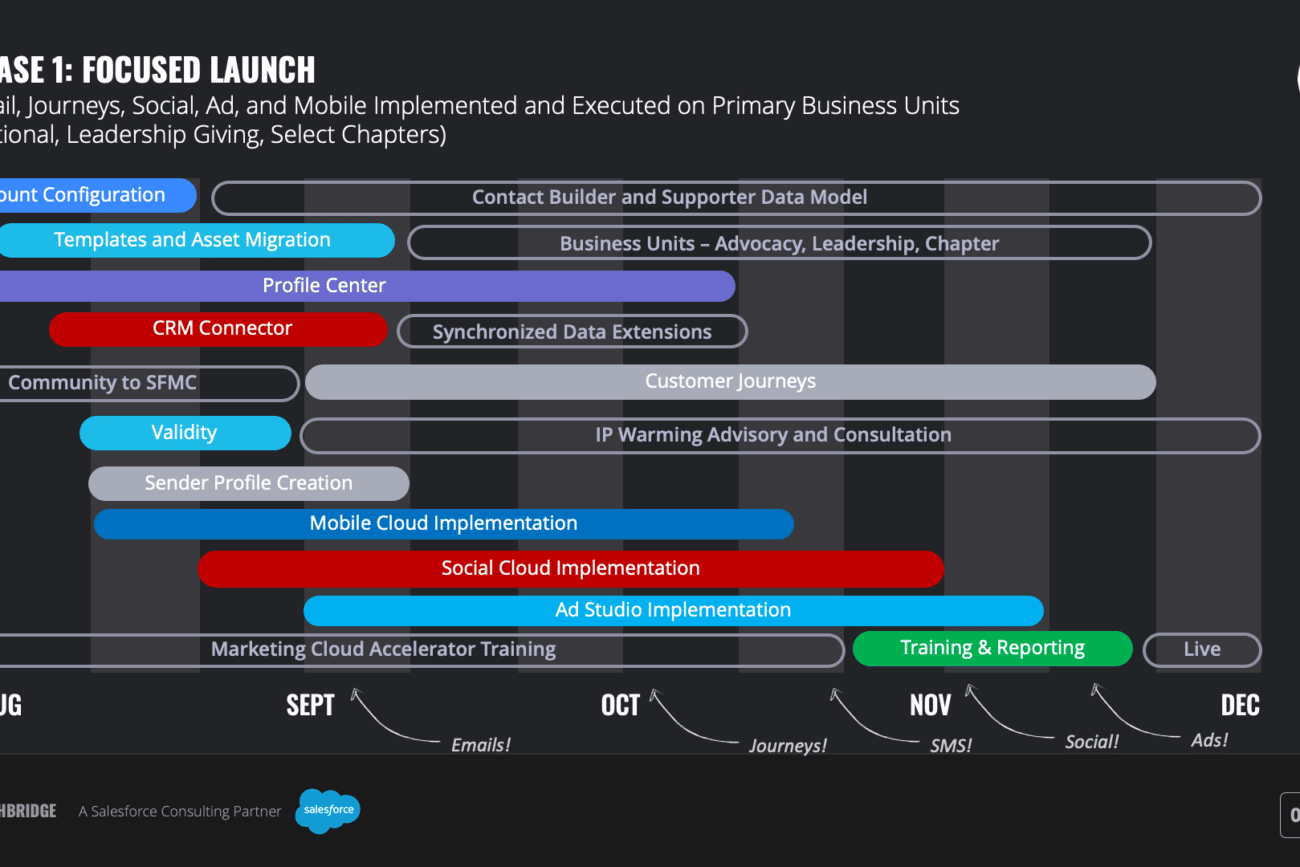A non-profit client decided to move their entire infrastructure over to Salesforce platforms and requested a project quote from Highbridge to determine the overall cost and timeline. We pushed back with them to enter an interim discovery project so we could better understand their team, their processes, their data, their challenges, and how to best prioritize the migration to Salesforce.
The platforms included Communities, Marketing Cloud, an external CRM integration, Validity (inbox placement monitoring), Mobile Cloud, Social Cloud, and Ad Studio.
Our team did a series of interviews with the leadership of the organization down to the lowest level employees. Leadership provided overall goals and vision, and management provided insight into resource, reporting, and process challenges, and low-level employees provided insight into their day-to-day work and challenges. The entire process took 90 days and included over 100 interviews.
The discovery uncovered a plethora of information that we utilized to develop a phased implementation for migration, operation, and evolution of their sales and marketing operations.
- Business Goals – Meeting with leadership, we were able to identify the key performance indicators for the organization, and their goals, so that we could properly prioritize the implementation.
- Stack – We were able to identify all systems that the company utilized, including several that had opportunities to integrate into their deployment.
- Data Flow – We were able to identify all entry points of data into the system, historical data, and current customer data to ensure migration plans were properly deployed.
- Data Quality Audit – The non-profit had several challenges, connecting consumer, business, multi-chapter, and multi-location events that had to be properly organized in their external CRM.
- Talent – We assisted leadership in identifying who on the team would be best suited to learn and be responsible for each stage or system. We also identified some risk on which employees may be lost in the transition.
- Process Audit – We identified and mapped all internal processes by employee and strategy to determine any automation opportunities to reduce workload.
- Journeys – We identified all touch points and customer journeys for their donors and sponsors.
- Messaging Audit – We audited multiple systems that were sending email and mobile communications.
- Customer Experience – We reviewed all analytics and reporting to identify and prioritize how to best optimize the customer experience for increased KPIs. Seasonality of their campaigns and processes were also documented so that we could align the implementation to avoid resource conflicts.
Executive Report
After transcribing and documenting all interviews with the team, we provided comprehensive reporting to the leadership team on the current state of their talent, systems, and processes. We uncovered a number of issues that leadership was not even aware of with respect to their donor base and engagement.
The resulting plan was presented with risks and concerns discussed with their leadership team. Included were:
- Phase 1 Focused Launch – A prioritization of implementation and migration to the key tools within the platforms, enterprise deployment plan with initial business units, professional development for the staff, schedule for training, and migration schedule for processes and communications through the new system.
- Phase 2 Chapter Expansion – Expanding the implementation through each of the chapters to migrate their data, processes, and develop their chapter teams in the deployment of the platforms.
- Phase 3: Optimization – A process for discovering opportunities to enhance the initial deployments, develop testing scenarios for improved KPIs, and development of Einstein predictions and recommendations to further segment and personalize communications.
Vision
We developed a vision that included:
- Customer Experience Vision – mockups and experience descriptions for each of the personas associated with their donor and sponsor base to provide a vision of email personalization, and customized preference center.
- Data Vision – A 360 degree view of their customer was provided, identifying event participation, volunteer opportunities, fundraising potential, advocacy, mentoring, and corporate sponsorship.
- Leadership Vision – We provided dashboard and reporting mockups for each level of management, providing insight into KPIs and personnel performance.
- Process Vision – We provided an overview of automated processes to reduce workload on existing staff and chapters to avail opportunities for increased creativity in deploying additional strategies.
Results
The result of the project was a unified vision that was communicated well from the highest level of leadership, through the chapters, and down through the staff to set expectations on the challenges and timeline for the enterprise implementation. The client was provided the opportunity at this point to pursue an implementation SOW with us, to do the work internally, or even select another partner to assist.
After careful consideration, the client chose a hybrid approach to work with us, offshore personnel, and their internal staff to complete the first phase of the implementation. We provided the account manager, project manager, trainers, and implementation technicians. We utilized their project management system (Atlassian) and uploaded all documentation and video training to Microsoft Teams.
The results were an implementation that was 8 months from launch to completion, a full 3 months ahead of schedule. Midway through the implementation, we even had to augment their staff due to some turnover. Because of this initial discovery, we were able to avoid dozens of downstream issues that would have; otherwise, hindered our deployments. We came in 38% below expected budget for the Phase 1 implementation.
At that point, the client was comfortable working on the next phases themselves.
